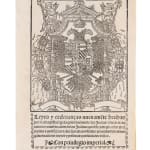![[American Law], Leyes y ordenancas nueuamente hechas por su Magestad pa[ra] la gouernacion de las Indias y buen tratamiento y conseruacion de los Indios: que se han de guardar en el consejo y audiencias reales que en ellas residen: y por todos los otros gouernadores juezes y personas particulare dellas. Con priuilegio imperial., 1543. Alcala de Henares. Joan de Brocar.](https://artlogic-res.cloudinary.com/w_1600,h_1600,c_limit,f_auto,fl_lossy,q_auto/artlogicstorage/hsrarebooks/images/view/37d3c579d04c61145aa3c73bde2ecc35j/hsrarebooks-american-law-leyes-y-ordenancas-nueuamente-hechas-por-su-magestad-pa-ra-la-gouernacion-de-las-indias-y-buen-tratamiento-y-conseruacion-de-los-indios-que-se-han-de-guard.jpg)
![[American Law], Leyes y ordenancas nueuamente hechas por su Magestad pa[ra] la gouernacion de las Indias y buen tratamiento y conseruacion de los Indios: que se han de guardar en el consejo y audiencias reales que en ellas residen: y por todos los otros gouernadores juezes y personas particulare dellas. Con priuilegio imperial., 1543. Alcala de Henares. Joan de Brocar.](https://artlogic-res.cloudinary.com/w_1600,h_1600,c_limit,f_auto,fl_lossy,q_auto/artlogicstorage/hsrarebooks/images/view/ad8809a8a203697e034350b946158b19j/hsrarebooks-american-law-leyes-y-ordenancas-nueuamente-hechas-por-su-magestad-pa-ra-la-gouernacion-de-las-indias-y-buen-tratamiento-y-conseruacion-de-los-indios-que-se-han-de-guard.jpg)
![[American Law], Leyes y ordenancas nueuamente hechas por su Magestad pa[ra] la gouernacion de las Indias y buen tratamiento y conseruacion de los Indios: que se han de guardar en el consejo y audiencias reales que en ellas residen: y por todos los otros gouernadores juezes y personas particulare dellas. Con priuilegio imperial., 1543. Alcala de Henares. Joan de Brocar.](https://artlogic-res.cloudinary.com/w_1600,h_1600,c_limit,f_auto,fl_lossy,q_auto/artlogicstorage/hsrarebooks/images/view/bbff9a338acac3cf5bfc3b856945d80dj/hsrarebooks-american-law-leyes-y-ordenancas-nueuamente-hechas-por-su-magestad-pa-ra-la-gouernacion-de-las-indias-y-buen-tratamiento-y-conseruacion-de-los-indios-que-se-han-de-guard.jpg)
![[American Law], Leyes y ordenancas nueuamente hechas por su Magestad pa[ra] la gouernacion de las Indias y buen tratamiento y conseruacion de los Indios: que se han de guardar en el consejo y audiencias reales que en ellas residen: y por todos los otros gouernadores juezes y personas particulare dellas. Con priuilegio imperial., 1543. Alcala de Henares. Joan de Brocar.](https://artlogic-res.cloudinary.com/w_1600,h_1600,c_limit,f_auto,fl_lossy,q_auto/artlogicstorage/hsrarebooks/images/view/b79c3b5df8598a070d26d2491e2aab44j/hsrarebooks-american-law-leyes-y-ordenancas-nueuamente-hechas-por-su-magestad-pa-ra-la-gouernacion-de-las-indias-y-buen-tratamiento-y-conseruacion-de-los-indios-que-se-han-de-guard.jpg)
![[American Law], Leyes y ordenancas nueuamente hechas por su Magestad pa[ra] la gouernacion de las Indias y buen tratamiento y conseruacion de los Indios: que se han de guardar en el consejo y audiencias reales que en ellas residen: y por todos los otros gouernadores juezes y personas particulare dellas. Con priuilegio imperial., 1543. Alcala de Henares. Joan de Brocar.](https://artlogic-res.cloudinary.com/w_1600,h_1600,c_limit,f_auto,fl_lossy,q_auto/artlogicstorage/hsrarebooks/images/view/f899e7b0a27dd62205e1823624d034b2j/hsrarebooks-american-law-leyes-y-ordenancas-nueuamente-hechas-por-su-magestad-pa-ra-la-gouernacion-de-las-indias-y-buen-tratamiento-y-conseruacion-de-los-indios-que-se-han-de-guard.jpg)
![[American Law], Leyes y ordenancas nueuamente hechas por su Magestad pa[ra] la gouernacion de las Indias y buen tratamiento y conseruacion de los Indios: que se han de guardar en el consejo y audiencias reales que en ellas residen: y por todos los otros gouernadores juezes y personas particulare dellas. Con priuilegio imperial., 1543. Alcala de Henares. Joan de Brocar.](https://artlogic-res.cloudinary.com/w_1600,h_1600,c_limit,f_auto,fl_lossy,q_auto/artlogicstorage/hsrarebooks/images/view/ccca7ec24c99e3c7877e5c5ad9c63024j/hsrarebooks-american-law-leyes-y-ordenancas-nueuamente-hechas-por-su-magestad-pa-ra-la-gouernacion-de-las-indias-y-buen-tratamiento-y-conseruacion-de-los-indios-que-se-han-de-guard.jpg)
![[American Law], Leyes y ordenancas nueuamente hechas por su Magestad pa[ra] la gouernacion de las Indias y buen tratamiento y conseruacion de los Indios: que se han de guardar en el consejo y audiencias reales que en ellas residen: y por todos los otros gouernadores juezes y personas particulare dellas. Con priuilegio imperial., 1543. Alcala de Henares. Joan de Brocar.](https://artlogic-res.cloudinary.com/w_1600,h_1600,c_limit,f_auto,fl_lossy,q_auto/artlogicstorage/hsrarebooks/images/view/d34939a2bf4b9b05c49c13cefad0b197j/hsrarebooks-american-law-leyes-y-ordenancas-nueuamente-hechas-por-su-magestad-pa-ra-la-gouernacion-de-las-indias-y-buen-tratamiento-y-conseruacion-de-los-indios-que-se-han-de-guard.jpg)
[American Law]
promulgated at the instances of Bishop Bartolome de Las Casas.
First edition, of pivotal transcendence, a work that altered the Spanish
position towards Native Americans and their relation with the
conquistadors, the first book dedicated solely to American Law and to
the betterment of the treatment of the indigenous population, including,
extraordinarily, an abolition cause. Of superlative rarity institutionally
and in the market.
Further images
Small folio, (271 x 198 mm). 14 ff. Unbound, housed in a fine custom navy morocco slipcase & chemise removed from a volume, expert restoration to marginal worming and old folds, cleaned, with pulp repairs to infilled losses. Printed in a round Spanish gothic type, title page with woodcut frame border, dominated by a large coat of arms of Charles V by Juan de Vingles; ff. II with large initial portraying King David in prayer.
“We ordain and command that from henceforward for no cause of war nor any other whatsoever, though it be under title of rebellion, nor by ransom nor in other manner can an Indian be made a slave, and we will that they be treated as our vassals of the Crown of Castile since such they are.”
“So rare that we can only refer to two copies in America, one in the Lenox Library, and one belonging to Samuel L. M. Barlow.” (Sabin).
“These two Ordinances of Charles V are the first separate printed laws relating to the New World, and were issued especially to ensure the better treatment of the Aborigines, and for limiting the partition of lands among the Conquistadores.” (Lathrop Harper).
“They were issued especially for the better treatment of the Indians, and, we believe, for limiting the partitions of lands among the conquerors.” (Harrisse).
Historical context and contents:
Hernán Cortes led the conquest of Mexico in 1519 and served as governor of New Spain from 1521-4. The impact of Spanish colonisation on the Indigenous population is well-documented, and while Cortes remains the poster-child for these excesses, the devastation commenced at first contact. “It took a full half century, from 1493 to 1543, to achieve, in legal and papal form, the complete cycle of devastation and degradation of the Aboriginal races ...” (Stevens & Lucas, ix). Of course, there was opposition and this legislation was partly due to the efforts of Bartolomé de las Casas (1484-1566) the Dominican Friar and “protector of the Indians” who wrote a series of works arguing for the better treatment of Indigenous Americans. These New Laws were for the territory including New Spain, Peru, Guatemala, Nicaragua and Hispanola.
This document seeks to codify better treatment for the Indigenous people [all translations are from Stevens]: “because our chief intention and will has always been and is the preservation and increase of the Indians, and that they be instructed and taught in the matters of our holy Catholic faith, and be well treated as free persons.”
The work is composed of two parts, each being a law promulgated by Charles V of Spain addressed to the ruling of the Indies, and more specifically to be better treatment of the Native Americans, and to limit the partitions of lands amongst the Conquistadores (targeting the encomienda system, prohibiting the creation of new ones and the inheritance of the existing ones). As per the latter ordinance, the law was immediately repelled in the Americas, causing such a strong objection –and rebellion-, that a revision of it was subsequently made. Regarding the ordinance addressed to the treatment of the Native Americans, it “explicitly banned the enslavement of Indians, even as punishment for crimes” (John Cowans, Early Modern Spain A Documentary History, University of Pennsylvania Press, Philadelphia, pp. 74). The better treatment of the Indians was turning into an issue of paramount importance, especially thanks to the efforts of Bishop Las Casas who championed loudly the cause, soon reaching the ears of the King, shaming him for the behavior of his officials in the Indies.
The Crown takes a further step in this direction with the following: “We ordain and command that from henceforward for no cause of war nor any other whatsoever, though it be under title of rebellion, nor by ransom nor in other manner can an Indian be made a slave, and we will that they be treated as our vassals of the Crown of Castile since such they are.”
This anti-slavery law includes “those who until now have been enslaved against all reason and right and contrary to the provisions and instructions thereupon.” Furthermore, “no risk of life, health and preservation of the said Indians may ensue from immoderate burthen; and that against their own will and without being paid, in no case be it permitted that they be laden, punishing very severely him who shall act contrary to this.” This included working in the pearl fisheries. Critically, it states that any Indigenous Americans who are found being treated or held in such a manner will be removed and “placed under our Royal Crown.”
This leads to labour practices in the Spanish Empire and the relationship between the Crown and colonists . “When the Spaniards conquered the New World, they resorted to a system of forced labor called the encomienda . Anencomienda was an organization in which a Spaniard received a restricted set of property rights over Indian labor from the Crown whereby the Spaniard (an encomendero) could extract tribute (payment of a portion of output) from the Indians in the form of goods, metals, money, or direct labor services” (Yeager). In exchange, the encomendero, was obliged to provide for their protection, education, and religious welfare.
There are differences which distinguish this system from the slavery practised later in the Caribbean and United States. The Indigenous Americans were not owned, and thus could not be bought or sold; there was no inheritance built into the system (rights reverted to the Crown); nor could they be moved or relocated from their homes. But in practical terms - specifically the experience of the Indigenous American - there was little difference, and indeed many were enslaved outside of the encomienda system, which these New Laws addresses. To give an example of the scale of the system, Córtes himself was granted an encomienda that included 115,000 people and “it was generally recognized that some of these personal service activities contributed greatly to the destruction of the Indians” (Batchelder and Sanchez, 49).
Here the New Laws set out the following: “These regulations limited personal services to encomenderos, made Crown officials responsible for determining the amount and composition of the tribute from encomiendas, prohibited the creation of new encomiendas and the reassignment of old ones and freed Indian slaves” (ibid, 57). If it seems too good to be true, it was. The Crown applied these restrictions largely to curtail the power and wealth of their own colonists. Importantly, with rights reverting to the Crown, Spain retained complete control over its American colonies. And in what became a truism for colonies in the Americas the next four hundred years, the implementation of these laws was hindered by lobbying by colonists.
Harisse confirms this: “They were issued especially for the better treatment of the Indians, and, we believe, for limiting the partitions of lands among the conquerors. Leon Pinelo states, on the authority of Juan de Grivalja, that these laws ‘tan odiosas,’ were prompted by the publication of the manuscript tract ’Dies i seis remedios contra la peste que destruye las Indias.’ They were issued at Barcelona, November 20th, 1542, completed at Valladolid, July 4th, 1543, and ordered to be printed, and enforced immediately throughout the Indies.”
The New Laws concerns would reverberate through the next four hundred years of colonization, both its riches and horrors.
Census of copies:
We could only trace copies at the University of Michigan Law Library, JCB, NYPL, Newberry, Bayerische Staatsbibliothek, BL (printed on vellum), Huntington Library, and the BNE. Only one copy has appeared on the trade, that of Lathrop Harper, over 60 years ago.
Provenance: Private collection, Spain; bought from the Spanish trade, offered with a Spanish export license. Offered in partnership with Maggs Bros.
Brunet “Manuel du Libraire,” III., col. 1042; Church, 80; Harrisse, “Bib. Am. Vet.,” No. 247; Sabin, 40902 ; Batchelder, R.W. & Sanchez, N., "The encomienda and the optimizing imperialist: an interpretation of Spanish imperialism in the Americas" in Public Choice , Vol. 156, No. 1/2 (July, 2013) pp.45-60; Stevens H., & Lucas, F.,Leyes y ordenanças nuevamente hechas: the new laws of the Indies for the good treatment and preservation of the Indians ... (London, 1893); Yeager, T., “Encomienda or Slavery? The Spanish Crown’s Choice of Labor Organization in Sixteenth-Century Spanish America” in The Journal of Economic History , Vol. 55, No. 4 (Dec., 1995), p.843.
Join our mailing list
* denotes required fields
We will process the personal data you have supplied in accordance with our privacy policy (available on request). You can unsubscribe or change your preferences at any time by clicking the link in our emails.







